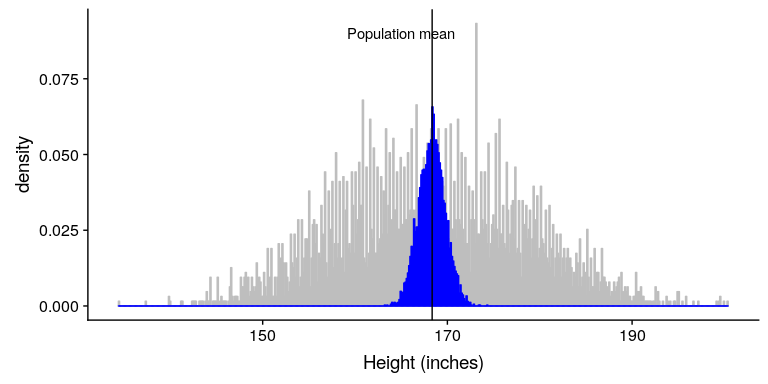## 7.2 采樣誤差
不管我們的樣本有多具有代表性,我們根據樣本計算的統計數據很可能至少與總體參數略有不同。我們稱之為 _ 采樣誤差 _。我們的統計估計值也會因樣本而異;我們將我們的統計數據在樣本間的分布稱為 _ 抽樣分布 _。
抽樣誤差直接關系到人口測量的質量。顯然,我們希望從樣本中獲得的估計值盡可能接近總體參數的真實值。然而,即使我們的統計數據是無偏的(也就是說,從長遠來看,我們希望它與總體參數具有相同的值),任何特定估計的值都將不同于總體估計,并且當抽樣誤差較大時,這些差異將更大。因此,減小采樣誤差是實現更好測量的重要步驟。
我們將使用 nhanes 數據集作為示例;我們將假設 nhanes 是整個總體,然后我們將從總體中隨機抽取樣本。在下一章中,我們將有更多的話要說,關于“隨機”樣本的生成是如何在計算機中工作的。
```r
# load the NHANES data library
library(NHANES)
# create a NHANES dataset without duplicated IDs
NHANES <-
NHANES %>%
distinct(ID, .keep_all = TRUE)
#create a dataset of only adults
NHANES_adult <-
NHANES %>%
filter(
!is.na(Height),
Age >= 18
)
#print the NHANES population mean and standard deviation of adult height
sprintf(
"Population height: mean = %.2f",
mean(NHANES_adult$Height)
)
```
```r
## [1] "Population height: mean = 168.35"
```
```r
sprintf(
"Population height: std deviation = %.2f",
sd(NHANES_adult$Height)
)
```
```r
## [1] "Population height: std deviation = 10.16"
```
在這個例子中,我們知道成年人口的平均值和身高的標準偏差,因為我們假設 nhanes 數據集包含整個成年人口。現在,讓我們從 NHANES 人群中抽取 50 個個體的單個樣本,并將結果統計數據與人口參數進行比較。
```r
# sample 50 individuals from NHANES dataset
exampleSample <-
NHANES_adult %>%
sample_n(50)
#print the sample mean and standard deviation of adult height
sprintf(
'Sample height: mean = %.2f',
mean(exampleSample$Height)
)
```
```r
## [1] "Sample height: mean = 169.46"
```
```r
sprintf(
'Sample height: std deviation = %.2f',
sd(exampleSample$Height)
)
```
```r
## [1] "Sample height: std deviation = 10.07"
```
樣本平均值和標準差相似,但不完全等于總體值。現在,讓我們取 50 個個體的大量樣本,計算每個樣本的平均值,并查看得出的平均值抽樣分布。為了更好地估計抽樣分布,我們必須決定要采集多少樣本——在這種情況下,讓我們采集 5000 個樣本,以便我們對答案真正有信心。請注意,像這樣的模擬有時需要幾分鐘才能運行,并且可能會使您的計算機變得氣喘吁吁。圖[7.1](#fig:samplePlot)中的柱狀圖顯示,對 50 個個體的每個樣本估計的平均值有所不同,但總體而言,它們集中在人口平均值周圍。
```r
# compute sample means across 5000 samples from NHANES data
sampSize <- 50 # size of sample
nsamps <- 5000 # number of samples we will take
# set up variable to store all of the results
sampMeans <- array(NA, nsamps)
# Loop through and repeatedly sample and compute the mean
for (i in 1:nsamps) {
NHANES_sample <- sample_n(NHANES_adult, sampSize)
sampMeans[i] <- mean(NHANES_sample$Height)
}
sprintf(
"Average sample mean = %.2f",
mean(sampMeans)
)
```
```r
## [1] "Average sample mean = 168.33"
```
```r
sampMeans_df <- tibble(sampMeans = sampMeans)
```

圖 7.1 藍色柱狀圖顯示了來自 nhanes 數據集的 5000 多個隨機樣本的平均值的抽樣分布。完整數據集的柱狀圖以灰色顯示以供參考。
- 前言
- 0.1 本書為什么存在?
- 0.2 你不是統計學家-我們為什么要聽你的?
- 0.3 為什么是 R?
- 0.4 數據的黃金時代
- 0.5 開源書籍
- 0.6 確認
- 1 引言
- 1.1 什么是統計思維?
- 1.2 統計數據能為我們做什么?
- 1.3 統計學的基本概念
- 1.4 因果關系與統計
- 1.5 閱讀建議
- 2 處理數據
- 2.1 什么是數據?
- 2.2 測量尺度
- 2.3 什么是良好的測量?
- 2.4 閱讀建議
- 3 概率
- 3.1 什么是概率?
- 3.2 我們如何確定概率?
- 3.3 概率分布
- 3.4 條件概率
- 3.5 根據數據計算條件概率
- 3.6 獨立性
- 3.7 逆轉條件概率:貝葉斯規則
- 3.8 數據學習
- 3.9 優勢比
- 3.10 概率是什么意思?
- 3.11 閱讀建議
- 4 匯總數據
- 4.1 為什么要總結數據?
- 4.2 使用表格匯總數據
- 4.3 分布的理想化表示
- 4.4 閱讀建議
- 5 將模型擬合到數據
- 5.1 什么是模型?
- 5.2 統計建模:示例
- 5.3 什么使模型“良好”?
- 5.4 模型是否太好?
- 5.5 最簡單的模型:平均值
- 5.6 模式
- 5.7 變異性:平均值與數據的擬合程度如何?
- 5.8 使用模擬了解統計數據
- 5.9 Z 分數
- 6 數據可視化
- 6.1 數據可視化如何拯救生命
- 6.2 繪圖解剖
- 6.3 使用 ggplot 在 R 中繪制
- 6.4 良好可視化原則
- 6.5 最大化數據/墨水比
- 6.6 避免圖表垃圾
- 6.7 避免數據失真
- 6.8 謊言因素
- 6.9 記住人的局限性
- 6.10 其他因素的修正
- 6.11 建議閱讀和視頻
- 7 取樣
- 7.1 我們如何取樣?
- 7.2 采樣誤差
- 7.3 平均值的標準誤差
- 7.4 中心極限定理
- 7.5 置信區間
- 7.6 閱讀建議
- 8 重新采樣和模擬
- 8.1 蒙特卡羅模擬
- 8.2 統計的隨機性
- 8.3 生成隨機數
- 8.4 使用蒙特卡羅模擬
- 8.5 使用模擬統計:引導程序
- 8.6 閱讀建議
- 9 假設檢驗
- 9.1 無效假設統計檢驗(NHST)
- 9.2 無效假設統計檢驗:一個例子
- 9.3 無效假設檢驗過程
- 9.4 現代環境下的 NHST:多重測試
- 9.5 閱讀建議
- 10 置信區間、效應大小和統計功率
- 10.1 置信區間
- 10.2 效果大小
- 10.3 統計能力
- 10.4 閱讀建議
- 11 貝葉斯統計
- 11.1 生成模型
- 11.2 貝葉斯定理與逆推理
- 11.3 進行貝葉斯估計
- 11.4 估計后驗分布
- 11.5 選擇優先權
- 11.6 貝葉斯假設檢驗
- 11.7 閱讀建議
- 12 分類關系建模
- 12.1 示例:糖果顏色
- 12.2 皮爾遜卡方檢驗
- 12.3 應急表及雙向試驗
- 12.4 標準化殘差
- 12.5 優勢比
- 12.6 貝葉斯系數
- 12.7 超出 2 x 2 表的分類分析
- 12.8 注意辛普森悖論
- 13 建模持續關系
- 13.1 一個例子:仇恨犯罪和收入不平等
- 13.2 收入不平等是否與仇恨犯罪有關?
- 13.3 協方差和相關性
- 13.4 相關性和因果關系
- 13.5 閱讀建議
- 14 一般線性模型
- 14.1 線性回歸
- 14.2 安裝更復雜的模型
- 14.3 變量之間的相互作用
- 14.4“預測”的真正含義是什么?
- 14.5 閱讀建議
- 15 比較方法
- 15.1 學生 T 考試
- 15.2 t 檢驗作為線性模型
- 15.3 平均差的貝葉斯因子
- 15.4 配對 t 檢驗
- 15.5 比較兩種以上的方法
- 16 統計建模過程:一個實例
- 16.1 統計建模過程
- 17 做重復性研究
- 17.1 我們認為科學應該如何運作
- 17.2 科學(有時)是如何工作的
- 17.3 科學中的再現性危機
- 17.4 有問題的研究實踐
- 17.5 進行重復性研究
- 17.6 進行重復性數據分析
- 17.7 結論:提高科學水平
- 17.8 閱讀建議
- References
